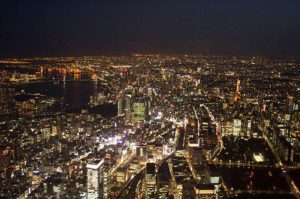
While the Japanese government has shown support for the commercial drone industry since former Prime Minister Shinzo Abe stated that drones were an important part of the fourth industrial revolution, drone regulations in Japan have limited drone traffic in cities and residential areas.
Continue reading below, or listen:
Now, Kyodo news reports that the ban on automated flights over residential areas has been lifted, clearing the way to more widespread drone delivery.
In April of 2015, an anti-nuclear protester used a consumer drone to deposit a small quantity of radioactive material on the roof of then-Prime Minister Shinzo Abe’s residence, prompting the enactment of strict rules about the flight of drones over residential areas. Until today, drone regulations in Japan allowed automated drone flights only over uninhabited areas including mountains, rivers, and farmlands.
Within those limitations, many drone delivery projects have already been deployed in Japan, which suffers from a serious labor shortage and supply chain difficulties to rural areas in Japan. This revision to the Civil Aeronautics Law, however, will clear the way for residential drone delivery in more populous areas and will allow existing delivery programs to operate more efficiently by taking more direct routes.
From the Kyodo News report:
- To ensure safe flights over houses, the government requires level-four drone flight operators obtain a license issued under a newly launched system and have their drones inspected and approved by the government or certified institutions.
- Drone pilots must renew their licenses every three years by taking written and skills tests. Those who complete courses held at state-designated institutions will be exempt from a skills test.
- For mass-produced drone models, safety approval is given to each model once clearing a government inspection of product design and manufacturing processes.
- The government requires drones used for level-four flights to undergo a flight test every year.
- Their flight schedules and courses must be submitted to the government, and operators must create internal guidelines on how to deal with operational risks and report accidents. Serious accidents will be investigated by the Japan Transport Safety Board.
Read more:
- SkyDrive Funding: Japanese Flying Car and Cargo Drone Company Scores More than $66 Million
- Japan Drone 2022 Draws More than 17,000 Visitors
- Volcanic Survey by Drone: HexaMedia Completes Mission in Japan 2,500m Above Sea Level
- Japans Night Hawks Fly Drone Search and Rescue Missions After Dark in Nishikawa
- Zipline and Toyota Tsusho Launch Medical Drone Delivery Service in Japan
Miriam McNabb is the Editor-in-Chief of DRONELIFE and CEO of JobForDrones, a professional drone services marketplace, and a fascinated observer of the emerging drone industry and the regulatory environment for drones. Miriam has penned over 3,000 articles focused on the commercial drone space and is an international speaker and recognized figure in the industry. Miriam has a degree from the University of Chicago and over 20 years of experience in high tech sales and marketing for new technologies.
For drone industry consulting or writing, Email Miriam.
TWITTER:@spaldingbarker
Subscribe to DroneLife here.
